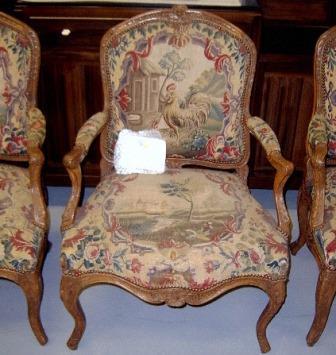In a letter dated 17 February 2005, the State Secretary for Education, Culture and Science asked the Restitutions Committee to issue a recommendation regarding the application for the restitution of the painting Charles, Prince de Rohan Soubise by J.F. Voet (NK 1840) and four 18th-century Louis XV armchairs (NK 656 A-D) from the former property of Milly Antonie von Friedländer-Fuld.
The Committee’s investigation revealed that the Jewish Milly Antoine Von Friedländer-Fuld had owned a valuable art and antiques collection. Up until 1939, the collection was located in her house in Berlin and moved to the Netherlands in 1939 where it was put in storage with a haulage company. To this end, the collection was inventoried whilst in storage, probably in connection with the various taxes imposed on Jewish assets in Nazi Germany at the time. It was assessed at RM 487,820. In 1939, Von Friedländer-Fuld left for France, where she died in 1943.
During the occupation of the Netherlands, her collection was considered enemy property by the Nazi regime and in 1941, it was confiscated by the ‘Sammelverwaltung feindlicher Hausgeräte’. Most items from the Friedländer-Fuld collection were auctioned off at the Hague auction house of Van Marle & Bignell, after which the individual works of art ended up with various Dutch and German buyers.
Consequently, the Committee considered the loss of possession of Von Friedländer-Fuld’s art collection a result of circumstances directly associated with the Nazi regime. The next question was whether a solid case could indeed be made for ownership rights of the claimed objects, which is a condition for restitution. In that regard, the claim for 18th-century Louis XV armchairs could not qualify as admissible. Although it had been determined that similar armchairs belonged to the looted property of Von Friedländer-Fuld, and the Origins Unknown Agency used the name Von Friedländer-Fuld as ‘possible provenance’ in its published investigation results, further investigation by the Committee was unable to confirm this ownership. A comparison of Von Friedländer-Fuld’s armchairs with the National Art collection armchairs based on photographic material and descriptions found in the archives brought to light a clear difference in chair frame, type of wood and respective scenes on the gobelin upholstery.
In contrast, the application for the restitution of the claimed portrait by Voet was admissible. The investigation revealed that this work of art certainly did belong to the Friedländer-Fuld collection. The painting was auctioned by Van Marle & Bignell in 1942 and finally ended up in the art collection destined for Hitler’s Führermuseum. After the war, the restoration of rights authorities returned the work of art to the Netherlands, but failed to establish a link between the painting and the Friedländer-Fuld collection.
In a meeting held on 3 July 2006, the Restitutions Committee recommended that application for the restitution of the four 18th-century Louis XV armchairs be rejected and that the application concerning the painting Charles, Prince de Rohan Soubise by J.F. Voet be admitted. The Minister adopted the recommendation in a decision taken on 5 October 2006.
